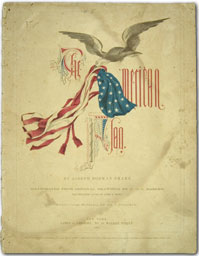
Joseph Rodman Drake's poem The American Flag was written during the second decade of the nineteenth century. Drake addressed the
symbol of the flag as mystical in origin, imagining the flag's first heavenly appearance. Words from Drake's first stanza..."She tore the azure
robe of night and set the stars of glory there", provided such a strong visual image it was chosen to accompany a lithograph by William Bauly,
based on an original painting by Frederic Edwin Church. Bauly's work, now in the Library of Congress collection, is entitled Our Heaven Born
Banner. Although at first less accepted then Francis Scott Key's Star- Spangled Banner, Drake's The American Flag, was later
favored by some after Key's anthem was criticized as warlike in tone.
Early in his career, Drake and his partner Fitz-Greene Halleck submitted three poems to William Coleman, the editor of the Evening Post. To
their great surprise, their writings were published the next day under Croaker and Company. The "Croaker" poems were controversial satirical
pieces that were the talk of the town in New York City. Drake's other works including, The Culprit Fay, and The American Flag,
catapulted him to the height of popularity as one of New York's most admired poets. Drake died at the age of 25 from Tuberculosis. In a tribute
to Drake and his contemporary Halleck, Edgar Allen Poe wrote: "...there are no American poems held in so high esteem by our countrymen, as the poems
of Drake and of Halleck."
In 1861, Drake's poem The American Flag was published as a song by James G. Gregory, with music composed by Vincenzo Bellini and
adapted by George Danskin. The drawings included in this songbook are the work of the celebrated artist Felix Octavius Carr Darley, who
dominated the book and magazine art illustration scene in America for over forty years. Darley is considered to be the "Father of American
Illustration" and is responsible for images included in the works of Washington Irving, Charles Dickens and Henry Wadsworth Longfellow. New York
landscape painter, wood engraver and illustrator, John A. Hows, illuminated Darley's drawings for the song, The American Flag.
Bibliography R. Bonner, Common-Place, Star-spangled Sentiment: The American Flag in Union and Disunion, available at
http://www.historycooperative.org [accessed 25 May 2005]; R. & J. Hester, site editors, F.O.C. Darley, available at
http://www.focdarley.org [accessed 6 October 2005]; G. Opitz ed., Mantle Fielding's Dictionary of American painters, Sculptors and Engravers,
New York, 1985. J. Rittenhouse, The Little Book of American Poets: 1787-1900, Boston, 1915; J. Slater, Early American Literature,
The Case of Drake and Halleck, available at www.cas.sc.edu/engl/eal/archives.htm [accessed 13 October 2005]; J. Wilson, The Poetical
Writings of Fitz-Greene Halleck, with Extracts from These of Joseph Rodman Drake, New York, 1969; The Collection National Gallery of Art,
Felix Octavius Carr Darley, available at http:// www.nga.gov/ [accessed 6 October 2005].
|

